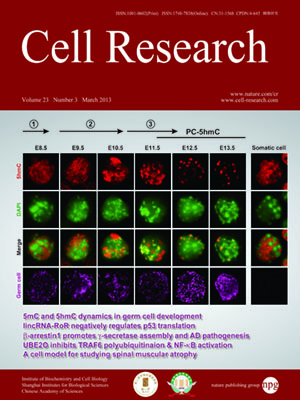
Volume 23, No 3, Mar 2013
ISSN: 1001-0602
EISSN: 1748-7838 2018
impact factor 17.848*
(Clarivate Analytics, 2019)
Volume 23 Issue 3, March 2013: 409-422
ORIGINAL ARTICLES
Analysis of the selectivity filter of the voltage-gated sodium channel NavRh
Xu Zhang1,2,3,*, Mengdie Xia2,4,*, Yang Li2,4,*, Huihui Liu2,4,*,Xin Jiang1,2,3, Wenlin Ren1,2,3, Jianping Wu1,2,3, Paul DeCaen5, Feng Yu6, Sheng Huang6,Jianhua He6, David E Clapham5, Nieng Yan1,2,3 and Haipeng Gong2,4
1State Key Laboratory of Bio-membrane and Membrane Biotechnology, Tsinghua University, Beijing 100084, China
2Center for Structural Biology, School of Life Sciences and School of Medicine, Tsinghua University, Beijing 100084, China
3Tsinghua-Peking Center for Life Sciences, Tsinghua University, Beijing 100084, China
4MOE Key Laboratory of Bioinformatics, Tsinghua University, Beijing 100084, China
5Howard Hughes Medical Institute, Department of Cardiology, Children's Hospital Boston, Department of Neurobiology, Harvard Medical School, Boston, MA 02115, USA
6Shanghai Institute of Applied Physics, Chinese Academy of Sciences, 239 Zhangheng Road, Shanghai 201204, China
Correspondence: Haipeng Gong(hgong@tsinghua.edu.cn)
NaChBac is a bacterial voltage-gated sodium (Nav) channel that shows sequence similarity to voltage-gated calcium channels. To understand the ion-permeation mechanism of Nav channels, we combined molecular dynamics simulation, structural biology and electrophysiological approaches to investigate the recently determined structure of NavRh, a marine bacterial NaChBac ortholog. Two Na+ binding sites are identified in the selectivity filter (SF) in our simulations: The extracellular Na+ ion first approaches site 1 constituted by the side groups of Ser181 and Glu183, and then spontaneously arrives at the energetically more favorable site 2 formed by the carbonyl oxygens of Leu179 and Thr178. In contrast, Ca2+ ions are prone to being trapped by Glu183 at site 1, which then blocks the entrance of both Na+ and Ca2+ to the vestibule of the SF. In addition, Na+ permeates through the selective filter in an asymmetrical manner, a feature that resembles that of the mammalian Nav orthologs. The study reported here provides insights into the mechanism of ion selectivity on Na+ over Ca2+ in mammalian Nav channels.
Cell Research (2013) 23:409–422; doi:10.1038/cr.2012.173; published online 18 December 2012
FULL TEXT | PDF
Browse 2606


